Your Comprehensive Guide to Residential
Circuit Breakers
The Role
of Circuit Breakers
Circuit breakers come in all shapes and sizes, but in this guide, we’re sticking to the ones that matter most to you – the ones in your home.

Whether your breaker panel is tucked away in a basement, garage, or outside on a wall, chances are you’ve had to deal with a tripped breaker at some point.
Frustrating? Yes. But these little devices are actually your home's first line of defense against electrical hazards.
So, what exactly do circuit breakers do? Think of them as electricity’s security guards.
They keep an eye on the flow of electricity in a circuit and when an overload occurs -- say, too many devices drawing power -- or when a short circuit happens because bare wires accidentally touch, the breaker jumps into action and shuts things down.
This split second response helps prevent overheating, damaged wiring, and worst-case scenarios like electrical fires.
Below is an example of an overloaded circuit in action -- something you definitely want to avoid.
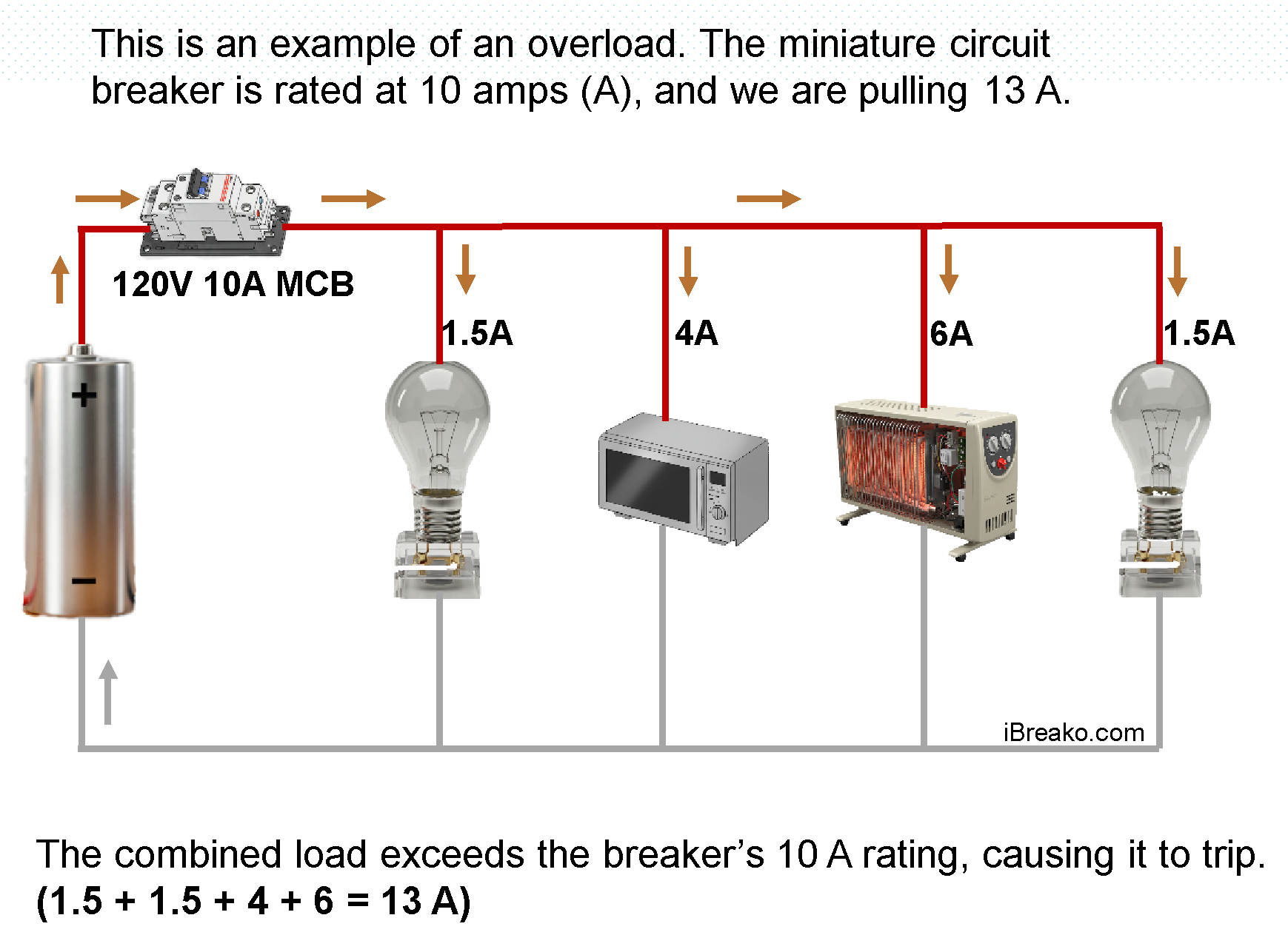
Short Circuit Example: When exposed wires make unintended contact, it's like an unplanned fireworks show -- brief, bright, and definitely not safe.
That sudden burst of energy can trip your breaker in an instant.

The miniature circuit breaker (MCB) is your electrical system’s bodyguard, instantly cutting power to stop overloads and short circuits.
Without it, wires overheat, sparks fly, and things get messy. let’s just say it wouldn’t end well.
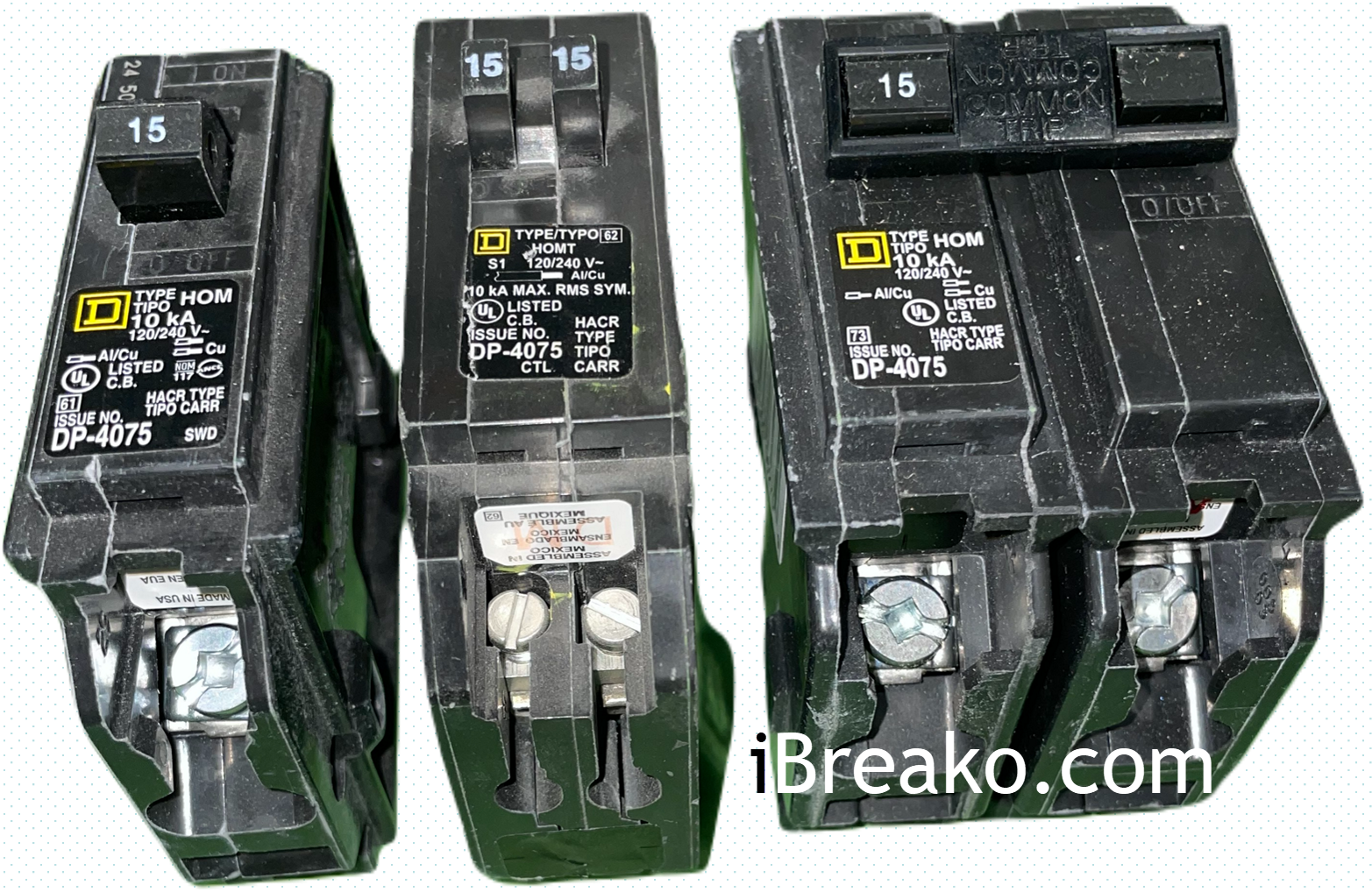
The Journey of Electricity and Its Protection
Now that you understand how circuit breakers act as your home's first line of defense, let's take a step back to explore the journey of electricity from its source to your doorstep.
Electricity travels along utility lines, either overhead or buried underground to reach your home. In this guide, we focus on the above ground system (because those are the ones you actually see).
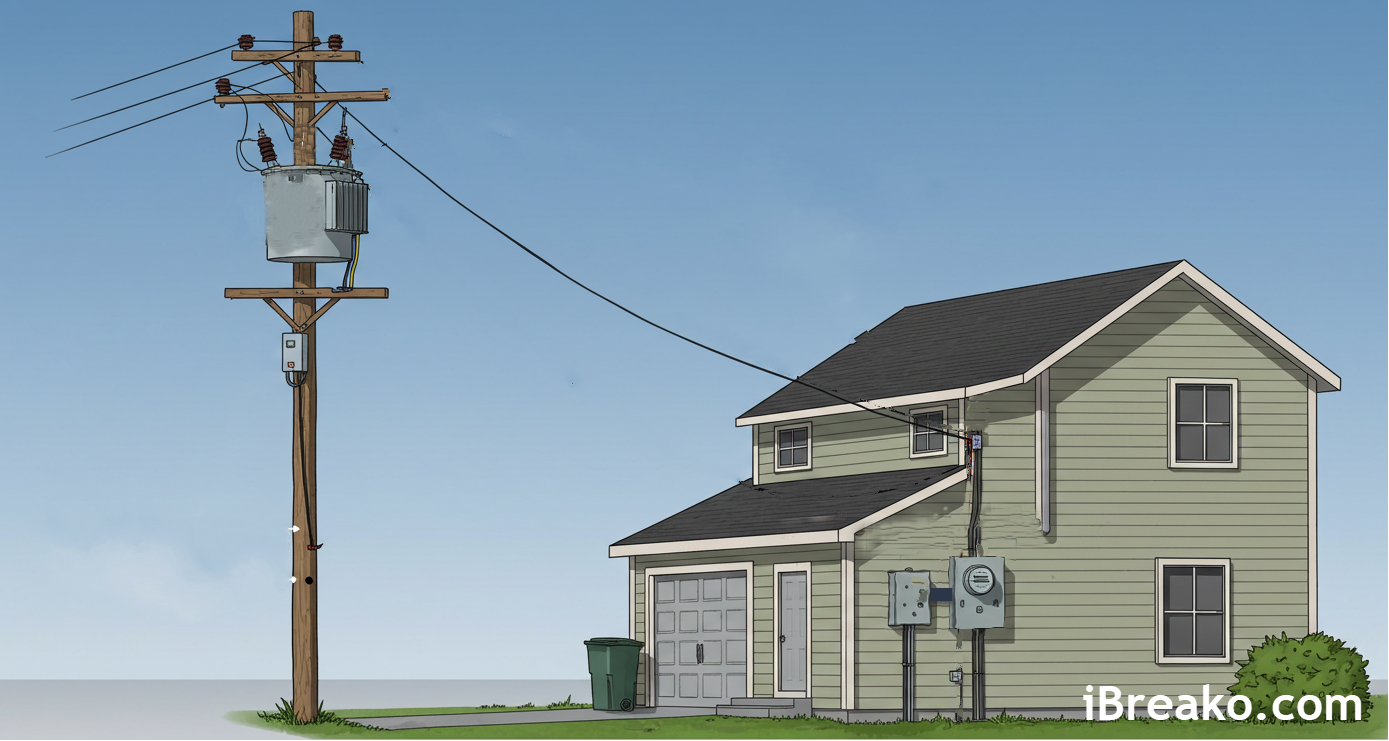
In North America, utility poles aren’t just there to mess up your view. They also hold single-phase overhead transformers (that is mouthful) that step down high voltage electricity from the power grid to the standard 120/240V your home uses.
These transformers take the 240V output and split it into two equal 120V lines, making sure your home gets power safely and efficiently.

Think of it like slicing a 240V pizza in half. The transformer’s center tap creates two 120V “slices,” both of which are “hot” compared to the neutral (which is grounded for safety). These two hot wires work together to power your home’s electrical system.
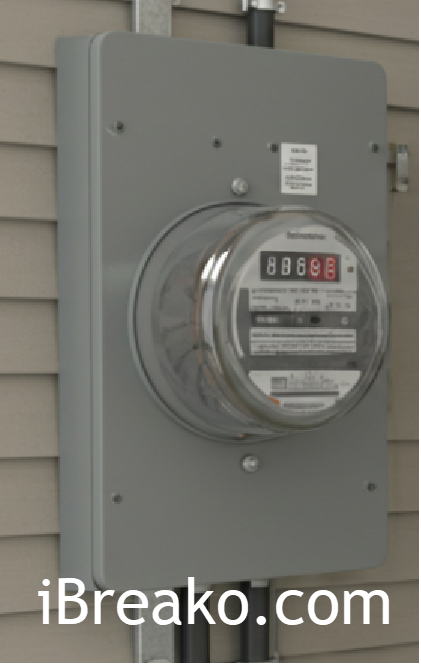
Before electricity reaches your panel, it makes a quick stop at your meter base, where your utility company keeps track of how much juice you’re using (and how much they can charge you for it). From there, it heads to your main electrical panel.
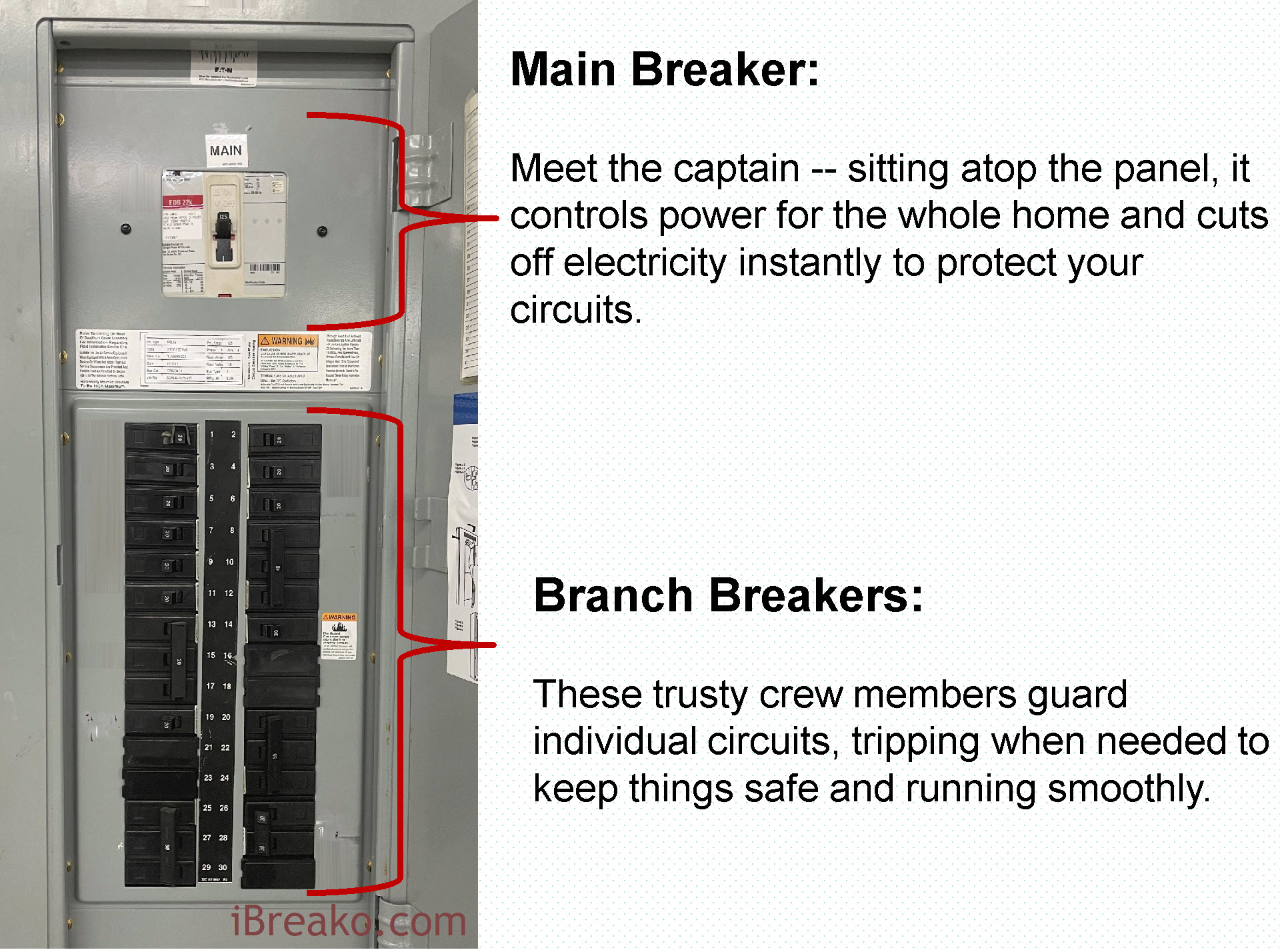
The electrical panel, also known as the breaker box or load center is where the real action happens. Inside the panel, you’ll find the main circuit breaker (or fuses in older systems), which acts as a master switch that controls power from the utility lines to all of your home’s circuits.
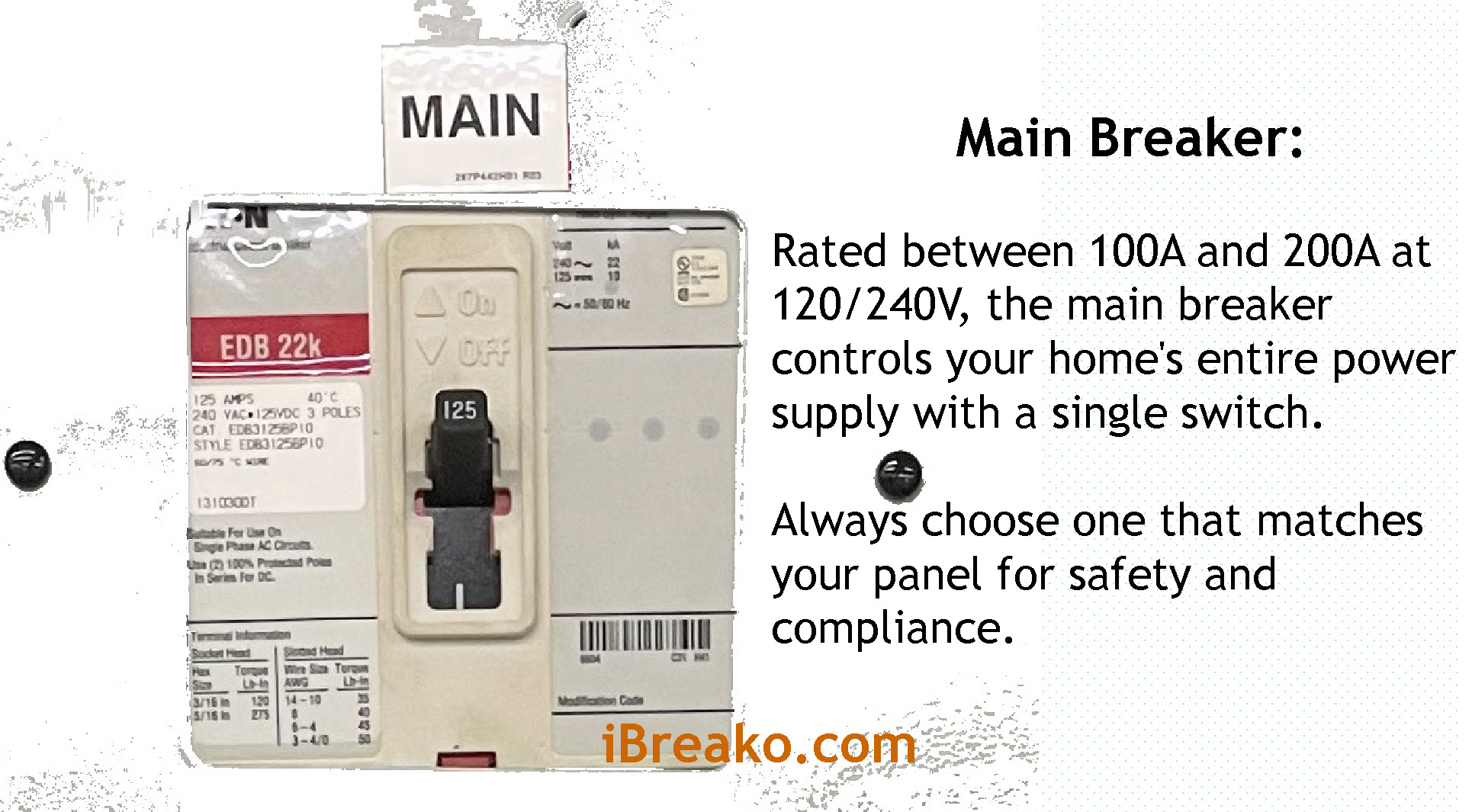
By turning off the main breaker (main service disconnect), it will cut off power to all branch breakers at once (though you might want to double check before you start poking around).
Each branch breaker then controls power to its designated circuit, tripping if there’s an overload or short circuit to keep your home safe.
The individual branch circuit breakers typically have current ratings ranging from 15 to 50 amps, depending on what they’re powering. The main breaker, which protects the entire electrical panel, is usually rated between 100 and 200 amps.

If your home
has high power needs, a subpanel is a great way to give your main panel some
backup.
Say you’ve got a 200A main panel, adding a 60A subpanel for your garage or
workshop keeps circuits organized and prevents overloads, making power
distribution more efficient.
Below is a list of the most common branch circuit breakers found in residential panels:
Miniature Circuit Breaker (MCB):
MCBs come in both single-pole and double-pole styles, acting as your home’s essential thermal-magnetic defenders against overcurrent issues.
Single-pole breakers are rated for 120V, these are the workhorses for everyday outlets, lighting, and small appliances.

Double-pole breaker is rated for 240V, these handle the heavy-duty appliances like ovens, dryers, and central air conditioners.
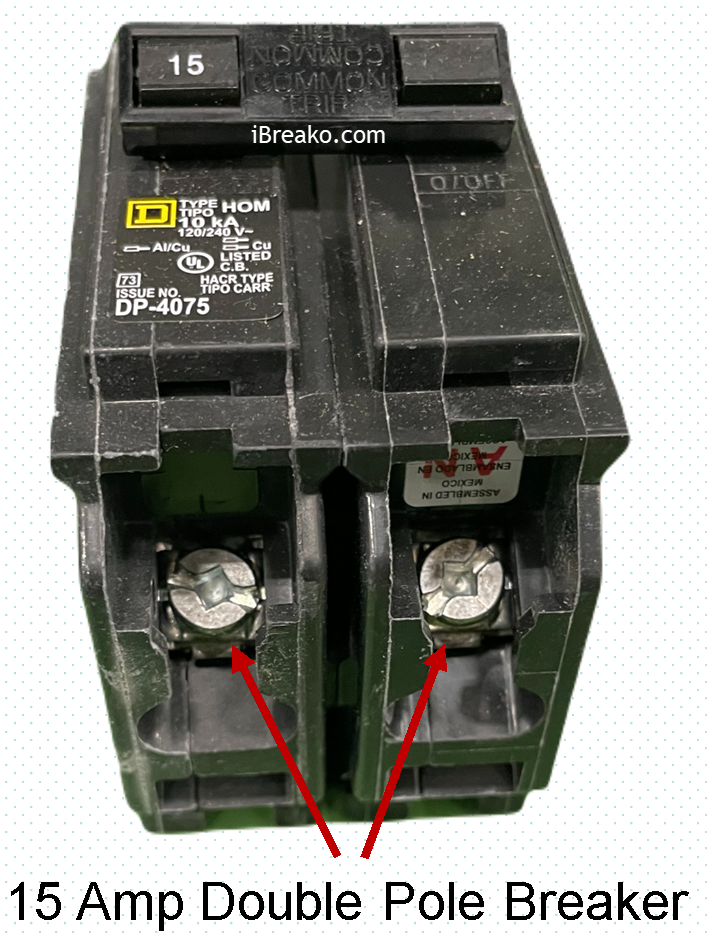
Tandem (Twin) Breakers:
Short on panel space? Tandem breakers let you fit two independent circuits into one slot, giving your panel a little extra room to breathe.
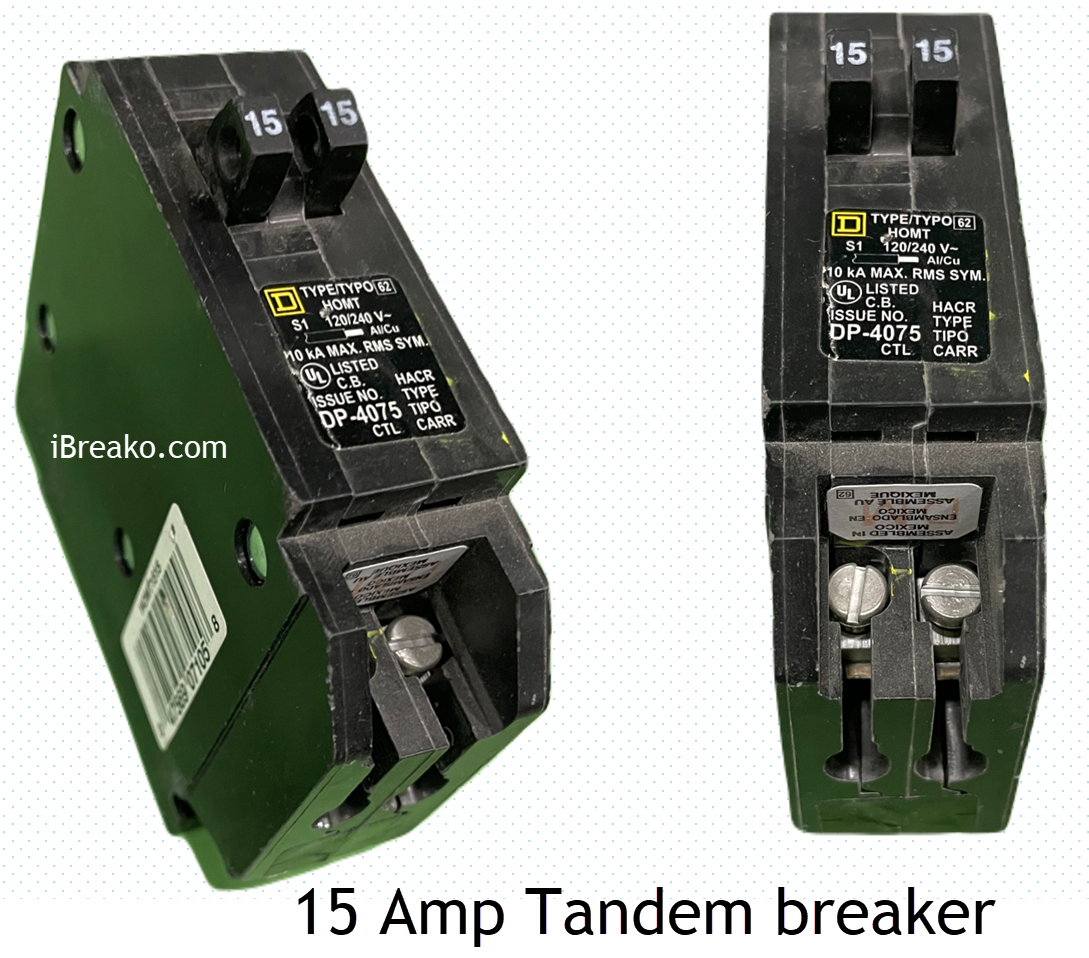
Multi-Pole Breakers:
Three-pole breakers usually work in three-phase panels, handling your heavy-duty power needs. And when it comes to unique circuits that need a full four-pole shutdown, quad breakers will do it.
GFCI Breakers:
These are your shock protectors. They detect current imbalances (ground faults) to prevent electric shock, an absolute must in bathrooms, kitchens, and outdoor areas.
AFCI Breakers:
Designed to sense dangerous arcing conditions, these breakers help cut down the risk of fires. You’ll typically find them in living areas and bedrooms.
Dual-Function Breakers (AFCI/GFCI):
Can’t decide between arc fault and ground fault protection? Dual-function breakers deliver both arc fault and ground fault protection in one breaker.
Why do circuit breakers trip?
Circuit breakers are designed to monitor the electrical current flowing through your home’s wiring, appliances, lights, and outlets. When one trips, it means something isn’t right and your system is stepping in to protect you.
Inside your electrical panel, you have a main circuit breaker and several branch breakers. If the main breaker trips while the branch breakers stay put, that’s a serious red flag.
Before you dive into troubleshooting, be honest about your electrical know-how. Safety always comes first.
Here are a few questions to help you pinpoint the issue:
- When did the tripping begin?
Was it right after installing a new appliance, or did it occur during a storm or power surge?
- What were you doing at the time?
Were multiple energy intensive devices running, like your oven, dryer, or HVAC running at once?
- Can you reset the main breaker?
Does it trip immediately even with all branch breakers off, or does it hold for a bit before tripping again under normal use?
Common Causes of Main Breaker Tripping
- Overloaded Circuit:
Running several energy intensive appliances like HVAC, EV chargers, electric oven or dryer at the same time can overload your circuit and trip the breaker.
- Short Circuit or Ground Fault:
If the breaker trips immediately, even when branch breakers are all OFF. There could be a direct short in the main panel cause by loose wires, damaged busbar or the meter socket.
- Faulty Main Breaker or Loose Busbar Connection:
A worn out breaker or poor contact with the busbar can cause frequent tripping.
- Arc Fault in the Main Wiring:
Degraded wires between the meter and main panel could cause an arc.
Main breaker trips aren’t normal, they signal real problems. If it keeps happening, your issue may not be just inside your home but with your utility service or the breaker itself.
Now, let’s shift focus to branch circuit breakers and track down the troublemaker:
Step 1: Identify the Affected Circuit
Determine which circuit or area the breaker controls. Narrowing it down will helps you focus on potential issues.
Step 2: Unplug and Turn ON
Once you’ve pinpointed the circuit, unplug all devices and appliances on it, then try resetting the breaker.
If it trips again immediately, there might be a wiring issue, faulty outlets, a bad connection, or even a faulty breaker. If it stays on, move on to the next step.
Step 3: Identify the Culprit
Plug in your devices one at a time. If the breaker trips when a particular appliance is connected, that appliance is likely the cause.
Step 4: Verify Outlets and Switches.
Try the "bad" appliance in another outlet. If it works fine, the original outlet might be faulty.
There’s no magic fix for tripping breakers, but understanding how they work puts you ahead of the game.
And most importantly -- know your limits! If things seem over your head, call a licensed electrician. A few hundred bucks is a small price for safety (and peace of mind).
Do You Need an Electrical Panel Upgrade?
Here’s How to Tell
If your breaker box shows any of these warning signs, it's probably time for an upgrade. Plus, there are real benefits to replacing panels older than 30 years.
Outdated Panels or Fuse Boxes:
Those old electrical panels and fuse boxes aren't just outdated, they're trouble. Forget about missing modern safety features like GFCI or AFCI protection.
You'll struggle to even find replacement parts for these dinosaurs. And I'm talking about the whole panel system here, not just individual fuses.
Signs of Wear or Damage:
When the electrical panel itself starts falling apart, that's bad news. A cracked box is a serious hazard when it rains. If the external box is showing signs of wear, it would best to assess the condition of the interior.
You'll need an electrician to inspect the interior for issues such as discolored bus bars, rust, burn marks, or melted wires before they become dangerous.
Frequent Breaker Trips:
If your breakers keep tripping, something's not right. This issue could be an overloaded circuit, or maybe the breakers themselves are starting to fail. Either way, it's a sign your system is struggling.
Code Compliance:
That old panel might have been up to code when Bell Biv DeVoe was topping the charts, but today's standards are different. If you bring in an electrician for repairs and it needs inspection, the inspector creditability on the line! The panel probably will not pass.
Upgrading means your system meets current safety codes, plus your electrician can actually find parts when something breaks.
Insufficient Panel Capacity:
Thinking about adding a new home office or upgrading your kitchen? Your old panel probably can’t handle the extra load. Modern homes use way more electricity than they did decades ago.
Renewable Energy Integration:
Want solar panels? Your old breaker box probably isn't ready for two-way power flow. You'll need an updated panel that can support inverter and bidirectional utility meter for renewable energy.
Aging Home:
If your home is 30 to 50 years old, there’s a good chance the wiring and grounding don’t meet modern standards.
Even worse, you might have one of those infamous FPE, Pushmatic, or Zinsco panels that electricians run from. Get a pro’s opinion and a quote, it might be worse than you think.
Look, nobody upgrades their panel for fun. Going from 100A to 200A service isn't cheap, I get it. But sometimes it's not just about convenience, it's about safety.
Essential Questions for Upgrading Your
Electrical Service
Thinking about upgrading your electrical panel? Before
you dive in, take a step back and ask yourself these key questions to avoid
headaches later.
1. What’s Your End game?
Are you just adding a few circuits, or do you have big plans -- like a workshop, hot tub, or EV charger?
If you’re increasing amperage, make sure you plan for future expansion. Talk to your electrician about how many extra slots you’ll need down the road.
2. Get Multiple Quotes (Seriously, Do It)
Don’t just go with the first electrician you find. Call at least three licensed pros. The prices and service quality can vary a lot.
Independent electricians often offer better rates than big companies in my opinion, so it’s worth checking around.
3. Understand the Costs (and Be Ready for Shock)
Let’s be real, electrical panel upgrades aren’t cheap. Expect to pay between $3,000 and $8,500, depending on the panel size, circuit needs, rewiring, and location.
It’s a hefty bill, but your electrician isn’t trying to retire off your job. Prices are often negotiable, but keep it reasonable.
4. Plan for Power Outages
Your power will be completely off during the upgrade -- typically for 5 to 10 hours. This process involves your electrician, a city inspector, and your utility company, so schedule accordingly.
5. Inspections Are Part of the Deal
Your city inspector will check the new installation to ensure it meets National Electrical Code (NEC) and local requirements. There are no shortcuts here, which is good!
6. Choose the Right Panel Brand
Square D, Eaton, and Siemens are the big names, but your electrician may prefer something else.
Ask about replacement parts availability, warranty, and reliability -- because you don’t want a brand that’ll be impossible to find parts for later and it is causing so much money now.
7. Who Handles Permits & Inspections?
Most electricians take care of permits and scheduling inspections but always confirm. You don’t want any surprises (or delays).
8. Check for Rebates & Incentives
Some utility companies or local governments offer rebates or incentives for electrical upgrades. A little research could save you serious cash.
9. What’s Your Responsibility vs. the Utility’s?
Not everything in your electrical setup belongs to you -- some parts are the utility company’s responsibility. Make sure you know who’s in charge of what before the work starts.
(Check the diagram below for clarity.)
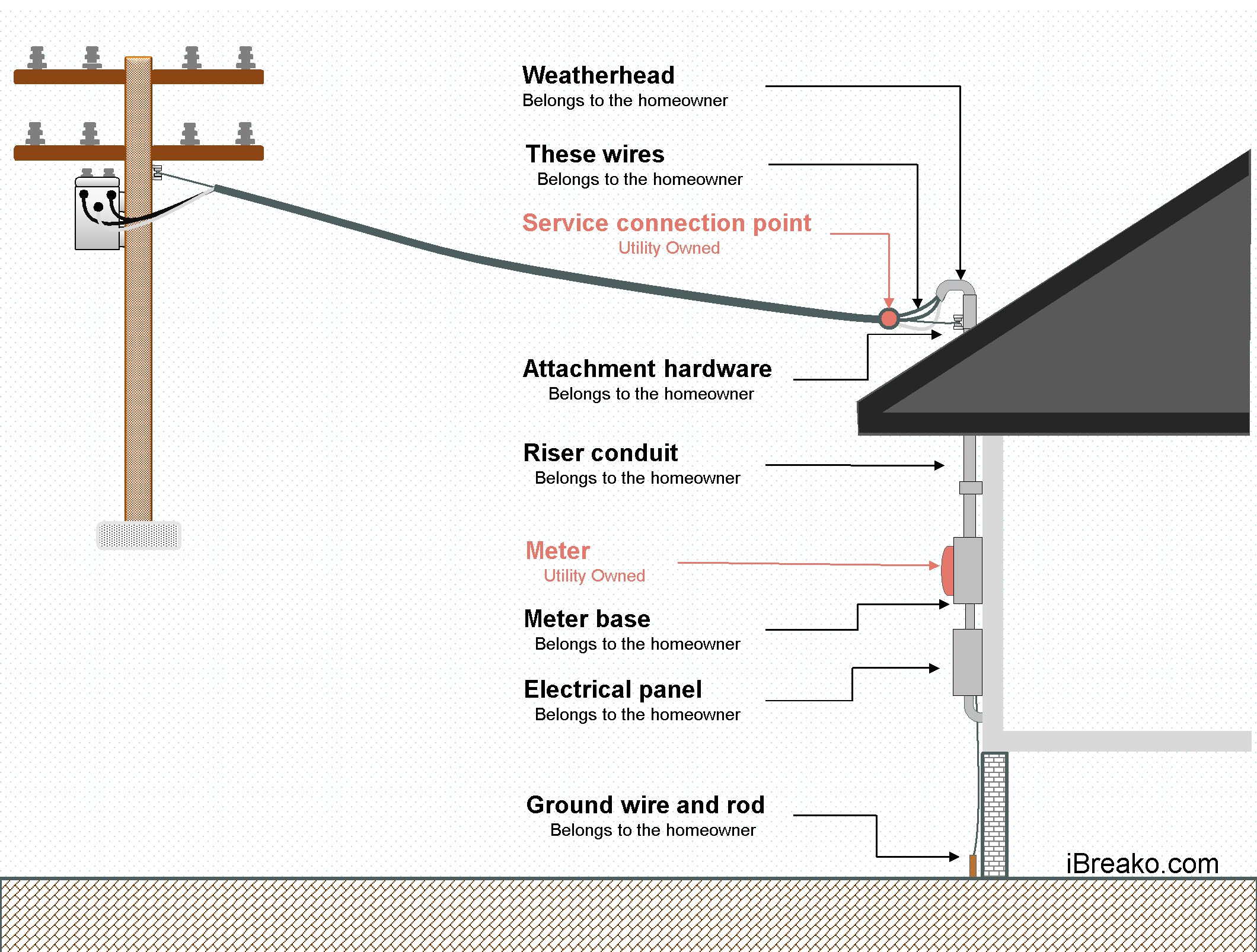
By thinking ahead and covering your bases, you’ll make your panel upgrade smooth and stress free. Your future self will appreciate what you have done.
Essential Safety Tips
Want to keep your home’s electrical system running smoothly (and avoid any shocking surprises)? Here are the tips:
Keep the Area Around Your Panel Clear: Keep boxes, coats, chest freezer, and flammable materials far away. You don’t want to turn a minor issue into huge hazard problem.
Label Your Panel: When something happens within your home, the last thing you want is a guessing game. Clearly mark each main and branch circuit breaker.
Avoid Overloading: Too many appliances on one circuit? That’s a recipe for trouble. And if the solution is flipping the breaker OFF and ON like a light switch that is bad idea.
Test Regularly: You installed GFCI outlets for safety, so make sure they actually work! Press the “TEST” button once a month. If nothing happens, well… better to find out now than in the middle of an emergency.
Don’t Force it: If a breaker won’t reset, don’t treat it like a stubborn jar lid. Forcing it could make things worse. Call a pro before you turn your panel into a DIY fireworks show.
Make Sure Everyone Knows the Basics: In an emergency, the last thing you need is panic. Teach your family how to shut off power safely. Know where the Main Breaker is and not just flip all the switches and see what happens.
Frequently Asked Questions
Q: Can I replace a circuit breaker myself?
A: Technically, yes. But unless you really know what you’re doing, it’s best to call a pro. Please, do not attempt to fix your breaker while watching YouTube tutorials.
Q: How long do circuit breakers last?
A: Usually 30 to 40 years, assuming they’re not constantly tripping or subjected to power surges. If yours is acting up way before then, it might be time for a replacement.
Q: Why do breakers trip during storms?
A: Lightning surges and power grid fluctuations can cause breakers to trip. Think of it as your electrical breaker way of saying, “Nope, not today.”
Q: What are the signs that a circuit breaker is failing?
A: If it keeps tripping, makes weird buzzing sounds, smells like something’s burning, or looks fried, it’s probably on its way out. Get it checked before it turns into a bigger problem.
I hope this basic guide has cleared up the mystery behind your electrical panel and shown you that these aren’t just boxes of switches. Understanding your electrical system is your first step toward preventing hazards and making smart choices.